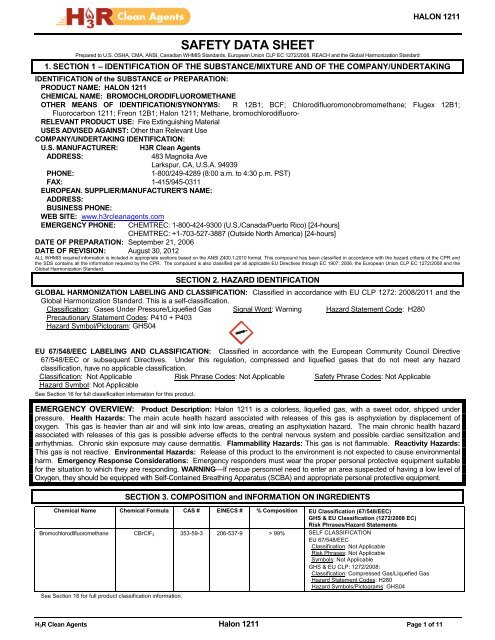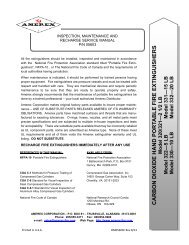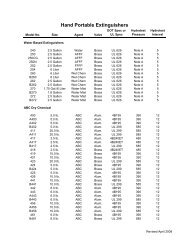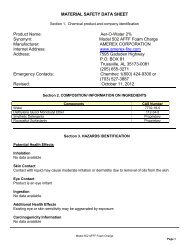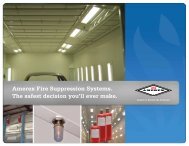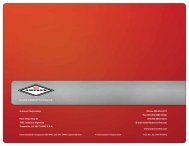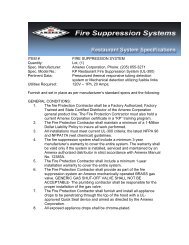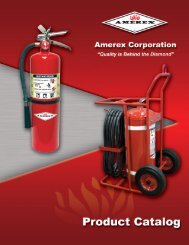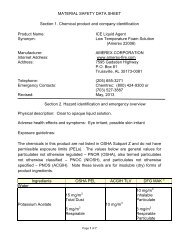halon english
halon english
halon english
- No tags were found...
You also want an ePaper? Increase the reach of your titles
YUMPU automatically turns print PDFs into web optimized ePapers that Google loves.
SECTION 11. TOXICOLOGICAL INFORMATION (Continued)HALON 1211ADDITIONAL TOXICOLOGICAL DATA (continued):Chronic (continued): Paresthesia of the fingers and other parts of the body was sometimes noted towards the end of theexperiment. Heart rate rose by approximately 30% during the early stages of exposure and remained at that level through theexperiment. Depression of the T wave was consistently observed on the ECG tracings. The subjects recovered rapidly oncessation of exposure and felt perfectly normal again within 5 minutes. The heart rate and the ECG reverted to normal within 1minute. There were no delayed after effects. Inhalation-Dog: At 5,000 to 100,000 ppm resulted in cardiac sensitization above20,000 ppm and in 10 to 0.5 minutes, depending on concentration.IRRITANCY OF PRODUCT: Not applicable.SENSITIZATION OF PRODUCT: Halon 1211 is not a human skin or respiratory sensitizer, but has been shown to be a cardiacsensitizer in animal studies.REPRODUCTIVE TOXICITY INFORMATION: Halon 1211 is not reported to cause mutagenic, embryotoxic, teratogenic orreproductive toxicity effects in humans. No animal data are available.BIOLOGICAL EXPOSURE INDICES (BEIs): Currently, Biological Exposure Indices (BEIs) have not been determined for Halon1211.SECTION 12. ECOLOGICAL INFORMATIONALL WORK PRACTICES MUST BE AIMED AT ELIMINATING ENVIRONMENTAL CONTAMINATION.MOBILITY: Using a structure estimation method based on molecular connectivity indices, the Koc for Halon 1211 can beestimated to be about 49. According to a classification scheme, this estimated Koc value suggests that Halon 1211 is expected tohave very high mobility in soil.PERSISTENCE AND BIODEGRADABILITY: Photodegradation: > 50% after 14 years. If released to air, a vapor pressure of2.07X10+3 mm Hg at 25°C indicates Halon 1211 will exist solely in the gas phase in the ambient atmosphere. Gas phaseBromochlorodifluoromethane will slowly be degraded in the atmosphere by reaction with photochemically-produced hydroxylradicals; the half-life for this reaction in air is estimated to be greater than 44 years. Halon 1211 absorbs very little UV radiationabove 290 nm and is not expected to photolyze at a significant rate in the ambient atmosphere. Volatilization from moist soilsurfaces is expected to be an important fate process based upon an estimated Henry's Law constant of 9.4X10-2 atm-cu m/mole.Halon 1211 will volatilize rapidly from dry soil surfaces since it exists as a gas in the ambient environment. If released into water,Halon 1211 is not expected to adsorb to suspended solids and sediment based upon the estimated Koc. Volatilization from watersurfaces is expected to be an important fate process based upon this compound's estimated Henry's Law constant. Estimatedvolatilization half-lives for a model river and model lake are 1.3 hrs and 5.1 days, respectively. Given its high degree ofhalogenation, it is not expected to be an important degradation pathway for Halon 1211.POTENTIAL TO BIOACCUMULATE: An estimated BCF of 5.8 was calculated for Halon 1211, using an estimated log Kow of1.9 and a regression-derived equation. According to a classification scheme, this BCF suggests the potential for bioconcentration inaquatic organisms is low.ECOTOXICITY: There is currently no evidence of adverse effects from exposure to Halon 1211 on aquatic life. Immediate adverseeffect on plants would be related to oxygen-deficient environments or frost from rapidly expanding gases.OZONE-DEPLETION POTENTIAL: Halon 1211 is rated as 3 (compared to trichlorofluoromethane nominally 1). Halon 1211 is aClass I ozone depleting chemical (40 CFR Part 82). Halon 1211 may contribute to global warming.ENVIRONMENTAL EXPOSURE CONTROLS: Controls should be engineered to prevent release to the environment,including procedures to prevent spills, atmospheric release and release to waterways.RESULTS OF PBT and vPvB ASSESSMENT: No data available. PBT and vPvB assessments are part of the chemical safetyreport required for some substances in European Union Regulation (EC) 1907/2006, Article 14.SECTION 13. DISPOSAL CONSIDERATIONSPRECAUTIONS TO BE FOLLOWED DURING WASTE HANDLING: Wear proper protective equipment when handlingwaste materials.UNUSED PRODUCT / EMPTY CONTAINER: Do not dispose of residual product. Return used product in cylinders to: H3RClean Agent Specialists, Inc.DISPOSAL INFORMATION: Relative to the environment, this material has an ozone depletion potential and a global warmingpotential. Refer to the regulations of the U.S. EPA or the State-specific regulations for proper waste disposal, regulations of Canadaand its Provinces, or regulations of EU member states.U.S. EPA WASTE NUMBER: Not applicable.EUROPEAN (EWC) WASTE CODES: 16 05 04* gases in pressure containers (including <strong>halon</strong>s) containing dangeroussubstancesSECTION 14. TRANSPORT INFORMATIONU.S. SHIPPING INFORMATION: This gas is classified as dangerous goods, per U.S. DOT regulations, under 49 CFR 172.101.UN IDENTIFICATION NUMBER: UN 1044U.S. DOT PROPER SHIPPING NAME:Fire extinguisher with compressed or liquefied gasHAZARD CLASS NUMBER and DESCRIPTION: 2.2 (Non-Flammable Gas)U.S. DOT SHIPPING LABEL(S) REQUIRED:Class 2.2 (Non-Flammable Gas)PACKING GROUP:Not ApplicablePLACARD (When required):Class 2.2 (Non-Flammable Gas)SPECIAL SHIPPING INFORMATION: Cylinders should be transported in a secure position in a well-ventilated truck (never transportin passenger compartment of a vehicle). Ensure cylinder valve is properly closed, valve outlet cap has been reinstalled, and valveprotection cap is secured before shipping cylinder.H 3 R Clean Agents Halon 1211 Page 6 of 11
HALON 1211SECTION 14. TRANSPORT INFORMATION (Continued)U.S. SHIPPING INFORMATION (continued):CAUTION: Compressed gas cylinders shall not be refilled except by qualified producers of compressed gases. Shipment of acompressed gas cylinder which has not been filled by the owner or with the owner’s written consent is a violation of Federal law (49CFR 173.301).ERG (EMERGENCY RESPONSE GUIDEBOOK) #: 126SPECIAL PROVISIONS: T50 Portable tanks - Applies to various liquefied compressed gases: Consult the regulations forspecific requirements Sec. 172.102 Special Provision Portable Tank Code T50.TRANSPORT CANADA TRANSPORTATION OF DANGEROUS GOODS REGULATIONS: This product is classified asDangerous Goods, per regulations of Transport Canada. The use of the above U.S. DOT information from the U.S. 49 CFR regulationsis allowed for shipments that originate in the U.S. For shipments via ground vehicle or rail that originate in Canada, the followinginformation is applicable.UN IDENTIFICATION NUMBER: UN 1044PROPER SHIPPING NAME:Fire extinguisher with compressed or liquefied gasHAZARD CLASS NUMBER and DESCRIPTION: 2.2 (Non-Flammable Gas)PACKING GROUP:Not ApplicableHAZARD SHIPPING LABEL(S) REQUIRED: Class 2.2 (Non-Flammable Gas)SPECIAL PROVISIONS:NoneEXPLOSIVE LIMIT & LIMITED QUANTITY INDEX: 0.125ERAP INDEX:NonePASSENGER CARRYING SHIP INDEX:NonePASSENGER CARRYING ROAD OR RAIL VEHICLE INDEX: 75INTERNATIONAL AIR TRANSPORT ASSOCIATION SHIPPING INFORMATION (IATA): This gas is classified asdangerous goods, per the International Air Transport Association.UN IDENTIFICATION NUMBER: UN 1044PROPER SHIPPING NAME/DESCRIPTION: Fire extinguisher with compressed or liquefied gasHAZARD CLASS or DIVISION:2.2 (Non-Flammable Gas)HAZARD LABEL(S) REQUIRED:Class 2.2 (Non-Flammable Gas)PACKING GROUP:NoneEXCEPTED QUANTITIES:E0PASSENGER and CARGO AIRCRAFT PACKING INSTRUCTION: 213PASSENGER and CARGO AIRCRAFT MAXIMUM NET QUANTITY PER PKG: 75 kgPASSENGER and CARGO AIRCRAFT LIMITED QUANTITY PACKING INSTRUCTION: ForbiddenPASSENGER and CARGO AIRCRAFT LIMITED QUANTITY MAXIMUM NET QUANTITY PER PKG: ForbiddenCARGO AIRCRAFT ONLY PACKING INSTRUCTION: 213CARGO AIRCRAFT ONLY MAXIMUM NET QUANTITY PER PKG: 150 kgSPECIAL PROVISIONS:A19ERG CODE:2LINTERNATIONAL MARITIME ORGANIZATION SHIPPING INFORMATION (IMO): This material is classified asdangerous goods, per the International Maritime Organization.UN No.: 1044PROPER SHIPPING NAME:Fire extinguisher with compressed or liquefied gasHAZARD CLASS NUMBER: 2.2PACKING GROUP:NoneSPECIAL PROVISIONS: 225LIMITED QUANTITIES:120 mLEXCEPTED QUANTITIES:E0PACKING:Instructions: P003; Provisions: NoneIBCs:Instructions: None; Provisions: NoneTANKS:Instructions: None; Provisions: NoneEmS:F-C, S-VSTOWAGE CATEGORY: Category A.MARINE POLLUTANT: This gas does not meet the criteria of a Marine Pollutant.EUROPEAN AGREEMENT CONCERNING THE INTERNATIONAL CARRIAGE OF DANGEROUS GOODS BYROAD (ADR): This gas is classified by the Economic Commission for Europe to be dangerous goods.UN NO.: 1044NAME and DESCRIPTION:Fire extinguisher with compressed or liquefied gasCLASS: 2CLASSIFICATION CODE:6APACKING GROUP:NoneLABELS: 2.2SPECIAL PROVISIONS: 225, 594LIMITED QUANTITIES:120 mLEXCEPTED QUANTITIES:E0PACKING INSTRUCTIONS:P003H 3 R Clean Agents Halon 1211 Page 7 of 11
SECTION 14. TRANSPORT INFORMATION (Continued)HALON 1211EUROPEAN AGREEMENT CONCERNING THE INTERNATIONAL CARRIAGE OF DANGEROUS GOODS BYROAD (ADR) [continued]:SPECIAL PACKING INSTRUCTIONS:NoneMIXED PACKING PROVISIONS:MP9PORTABLE TANK and BULK CONTAINER: Instructions: None; Special Provisions: NoneHAZARD IDENTIFICATION No.:NoneThe following shipping information applies when the product is supplied in types of cylinders other than fireextinguishers:U.S. SHIPPING INFORMATION:UN IDENTIFICATION NUMBER: UN 1974U.S. DOT PROPER SHIPPING NAME:Chlorodifluorobromomethane or Refrigerant gas R12B1HAZARD CLASS NUMBER and DESCRIPTION: 2.2 (Non-Flammable Gas)U.S. DOT SHIPPING LABEL(S) REQUIRED: Class 2.2 (Non-Flammable Gas)PACKING GROUP:Not ApplicablePLACARD (When required):Class 2.2 (Non-Flammable Gas)ERG (EMERGENCY RESPONSE GUIDEBOOK) #: 126SPECIAL SHIPPING INFORMATION: Cylinders should be transported in a secure position in a well-ventilated truck (nevertransport in passenger compartment of a vehicle). Ensure cylinder valve is properly closed, valve outlet cap has been reinstalled,and valve protection cap is secured before shipping cylinder.CAUTION: Compressed gas cylinders shall not be refilled except by qualified producers of compressed gases. Shipment of acompressed gas cylinder which has not been filled by the owner or with the owner’s written consent is a violation of Federal law (49CFR 173.301).SPECIAL PROVISIONS: T50 Portable tanks - Applies to various liquefied compressed gases: Consult the regulations forspecific requirements Sec. 172.102 Special Provision Portable Tank Code T50.TRANSPORT CANADA TRANSPORTATION OF DANGEROUS GOODS REGULATIONS:UN IDENTIFICATION NUMBER: UN 1974PROPER SHIPPING NAME:Chlorodifluorobromomethane or Refrigerant gas R12B1HAZARD CLASS NUMBER and DESCRIPTION: 2.2 (Non-Flammable Gas)PACKING GROUP:Not ApplicableHAZARD SHIPPING LABEL(S) REQUIRED: Class 2.2 (Non-Flammable Gas)SPECIAL PROVISIONS:NoneEXPLOSIVE LIMIT & LIMITED QUANTITY INDEX: 0.125ERAP INDEX:NonePASSENGER CARRYING SHIP INDEX:NonePASSENGER CARRYING ROAD OR RAIL VEHICLE INDEX: 75INTERNATIONAL AIR TRANSPORT ASSOCIATION SHIPPING INFORMATION (IATA):UN IDENTIFICATION NUMBER: UN 1974PROPER SHIPPING NAME/DESCRIPTION: Chlorodifluorobromomethane or Refrigerant gas R12B1HAZARD CLASS or DIVISION:2.2 (Non-Flammable Gas)HAZARD LABEL(S) REQUIRED:Class 2.2 (Non-Flammable Gas)PACKING GROUP:NoneEXCEPTED QUANTITIES:E1PASSENGER and CARGO AIRCRAFT PACKING INSTRUCTION: 200PASSENGER and CARGO AIRCRAFT MAXIMUM NET QUANTITY PER PKG: 75 kgPASSENGER and CARGO AIRCRAFT LIMITED QUANTITY PACKING INSTRUCTION: ForbiddenPASSENGER and CARGO AIRCRAFT LIMITED QUANTITY MAXIMUM NET QUANTITY PER PKG: ForbiddenCARGO AIRCRAFT ONLY PACKING INSTRUCTION: 200CARGO AIRCRAFT ONLY MAXIMUM NET QUANTITY PER PKG: 150 kgSPECIAL PROVISIONS:NoneERG CODE:2LINTERNATIONAL MARITIME ORGANIZATION SHIPPING INFORMATION (IMO):UN No.: 1974PROPER SHIPPING NAME:Chlorodifluorobromomethane or Refrigerant gas R12B1HAZARD CLASS NUMBER: 2.2PACKING GROUP:NoneSPECIAL PROVISIONS:NoneLIMITED QUANTITIES:120 mLEXCEPTED QUANTITIES:E1PACKING:Instructions: P200; Provisions: NoneIBCs:Instructions: None; Provisions: NoneTANKS:Instructions: T50; Provisions: NoneEmS:F-C, S-VSTOWAGE CATEGORY: Category A.MARINE POLLUTANT: This gas does not meet the criteria of a Marine Pollutant.H 3 R Clean Agents Halon 1211 Page 8 of 11
HALON 1211SECTION 14. TRANSPORT INFORMATION (Continued)EUROPEAN AGREEMENT CONCERNING THE INTERNATIONAL CARRIAGE OF DANGEROUS GOODS BYROAD (ADR):UN NO.: 1974NAME and DESCRIPTION:Chlorodifluorobromomethane or Refrigerant gas R12B1CLASS: 2CLASSIFICATION CODE:2APACKING GROUP:NoneLABELS: 2.2SPECIAL PROVISIONS:NoneLIMITED QUANTITIES:120 mLEXCEPTED QUANTITIES:E1PACKING INSTRUCTIONS:P200SPECIAL PACKING INSTRUCTIONS:NoneMIXED PACKING PROVISIONS:MP9PORTABLE TANK and BULK CONTAINER: Instructions: (M) T50; Special Provisions: NoneHAZARD IDENTIFICATION No.: 20TRANSPORT IN BULK ACCORDING TO THE IBC CODE: See the information under the individual jurisdiction listings forIBC information.ENVIRONMENTAL HAZARDS: This gas does not meet the criteria of environmentally hazardous according to the criteria ofthe UN Model Regulations (as reflected in the IMDG Code, ADR, RID, and ADN); this gas is not specifically listed in Annex III underMARPOL 73/78.SECTION 15. REGULATORY INFORMATIONU.S. FEDERAL REGULATIONS:EPA - ENVIRONMENTAL PROTECTION AGENCY:CERCLA: Comprehensive Environmental Response, Compensation, and Liability Act of 1990 (40 CFR Parts 117 and 302)Reportable Quantity (RQ): Not ApplicableSARA TITLE III: Superfund Amendment and Reauthorization ActSECTIONS 302/304: Emergency Planning and Notification (40 CFR Part 355)Extremely Hazardous Substances: Halon 1211 is not listed.Threshold Planning Quantity (TPQ): Not ApplicableReportable Quantity (RQ): Not ApplicableSECTIONS 311/312: Hazardous Chemical Reporting (40 CFR Part 370)IMMEDIATE HEALTH: No PRESSURE: Yes DELAYED HEALTH: No REACTIVITY: No FIRE: NoSECTION 313: Toxic Chemical Release Reporting (40 CFR 372)Releases of Halon 1211 require reporting under Section 313.CLEAN AIR ACT:SECTION 112 (r): Risk Management Programs for Chemical Accidental Release (40 CFR Part 68)Threshold Planning Quantity (TPQ): Not ApplicableTSCA: Toxic Substances Control ActHalon 1211 is listed in the TSCA InventoryOSHA - OCCUPATIONAL SAFETY AND HEALTH ADMINISTRATION:29 CFR Part 1910.119: Process Safety Management of Highly Hazardous Chemicals.Threshold Planning Quantity (TPQ): Not ApplicableOTHER U.S. FEDERAL REGULATIONS: Requirements under (40 CFR Part 82) may be applicable as Halon 1211 is designatedas an ozone-depleting compound.U.S. STATE REGULATORY INFORMATION:CALIFORNIA PROPOSITION 65: Halon 1211 is NOT listed on the California Proposition 65 lists.CANADIAN FEDERAL REGULATIONS:CANADIAN DSL INVENTORY STATUS: Halon 1211 is listed on the DSL Inventory.OTHER CANADIAN REGULATIONS: Halon 1211 is categorized as a Controlled Product, Hazard Class A, as per the ControlledProduct Regulations. Halon 1211 is not on the CEPA Priorities Substances Lists.CANADIAN WHMIS CLASSIFICATION and SYMBOLS: Class A: Compressed GasADDITIONAL EUROPEAN REGULATIONS:SAFETY, HEALTH, AND ENVIRONMENTAL REGULATIONS/LEGISLATION SPECIFIC FOR THE PRODUCT:Currently, there is no specific legislation pertaining to this product.CHEMICAL SAFETY ASSESSMENT: No data available. The chemical safety assessment is required for somesubstances according to European Union Regulation (EC) 1907/2006, Article 14.H 3 R Clean Agents Halon 1211 Page 9 of 11
HALON 1211SECTION 16. OTHER INFORMATIONGLOBAL HARMONIZATION AND EU CLP REGULATION (EC) 1272/2208 LABELING AND CLASSIFICATION:Classified in accordance with CLP Regulation (EC) 1272/2008. For information on classification under (67/548/EEC),see below.Classification: Gas under Pressure/Liquefied GasSignal Words: WarningHazard Statements: H280: Contains gas under pressure; may explode if heated.Prevention Statements:Precautionary: None.Response: NoneStorage: P410 + P403: Protect from sunlight. Store in a well-ventilated place.Disposal: P501: Dispose of contents/containers in accordance with all local, regional, national and international regulations.Hazard Symbol: GHS04EU 67/548/EEC LABELING AND CLASSIFICATION: Under European Union Council Directive 67/548/EEC andsubsequent Directives, this is no classification for simple compressed gases.Classification: None Risk Phrases: None Safety Phrases: None Hazard Symbol: NoneInformation contained in this Safety Data Sheet is provided to our customers so they may comply with 29 CFR 1910.1200, Hazard Communication Standard, the Canadian WHMISStandard, and the requirements of the European Union Directives. The intent of this Material Safety Data Sheet is to provide end users of this product with the health and physicalhazards associated with possible exposure to this product. All statements, technical data and recommendations are based on readily available texts and data that H 3 R Aviation,believes to be reliable and accurate. H 3 R Aviation makes no warranties, guarantees or representations of any kind with respect to this product or this data. It is the responsibility of theuser to obtain and use the most recent version of this MSDS.PREPARED BY: CHEMICAL SAFETY ASSOCIATES, Inc. PO Box 1961, Hilo, HI 96721 800/441-3365REFERENCES AND DATA SOURCES: Contact the supplier for information.METHODS OF EVALUATING INFORMATION FOR THE PURPOSE OF CLASSIFICATION: Bridging principles were used to classify thisproduct.REVISION DETAILS: August 2009: Review and up-date of MSDS to current Standards. August 2012: Review and up-date SDS, to includeEuropean CLP 1272: 2008 and Global Harmonization Standard Classification.DEFINITIONS OF TERMSA large number of abbreviations and acronyms appear on a MSDS. Some of these which are commonly used include the following:CAS #: This is the Chemical Abstract Service Number that uniquely identifies eachconstituent.EXPOSURE LIMITS IN AIR:CEILING LEVEL: The concentration that shall not be exceeded during any part of theworking exposure.DFG MAK Germ Cell Mutagen Categories: 1: Germ cell mutagens which have beenshown to increase the mutant frequency in the progeny of exposed humans. 2: Germ cellmutagens which have been shown to increase the mutant frequency in the progeny ofexposed mammals. 3A: Substances which have been shown to induce genetic damage ingerm cells of human of animals, or which produce mutagenic effects in somatic cells ofmammals in vivo and have been shown to reach the germ cells in an active form. 3B:Substances which are suspected of being germ cell mutagens because of their genotoxiceffects in mammalian somatic cell in vivo; in exceptional cases, substances for which thereare no in vivo data, but which are clearly mutagenic in vitro and structurally related to knownin vivo mutagens. 4: Not applicable (Category 4 carcinogenic substances are those withnon-genotoxic mechanisms of action. By definition, germ cell mutagens are genotoxic.Therefore, a Category 4 for germ cell mutagens cannot apply. At some time in the future, itis conceivable that a Category 4 could be established for genotoxic substances with primarytargets other than DNA [e.g. purely aneugenic substances] if research results make thisseem sensible.) 5: Germ cell mutagens, the potency of which is considered to be so lowthat, provided the MAK value is observed, their contribution to genetic risk for humans isexpected not to be significant.DFG MAK Pregnancy Risk Group Classification: Group A: A risk of damage to thedeveloping embryo or fetus has been unequivocally demonstrated. Exposure of pregnantwomen can lead to damage of the developing organism, even when MAK and BAT(Biological Tolerance Value for Working Materials) values are observed. Group B: Currentlyavailable information indicates a risk of damage to the developing embryo or fetus must beconsidered to be probable. Damage to the developing organism cannot be excluded whenpregnant women are exposed, even when MAK and BAT values are observed. Group C:There is no reason to fear a risk of damage to the developing embryo or fetus when MAKand BAT values are observed. Group D: Classification in one of the groups A-C is not yetpossible because, although the data available may indicate a trend, they are not sufficient forfinal evaluation.IDLH-Immediately Dangerous to Life and Health: This level represents a concentrationfrom which one can escape within 30-minutes without suffering escape-preventing orpermanent injury.LOQ: Limit of Quantitation.MAK: Federal Republic of Germany Maximum Concentration Values in the workplace.NE: Not Established. When no exposure guidelines are established, an entry of NE is madefor reference.NIC: Notice of Intended Change.NIOSH CEILING: The exposure that shall not be exceeded during any part of the workday.If instantaneous monitoring is not feasible, the ceiling shall be assumed as a 15-minute TWAexposure (unless otherwise specified) that shall not be exceeded at any time during aworkday.NIOSH RELs: NIOSH’s Recommended Exposure Limits.PEL-Permissible Exposure Limit: OSHA’s Permissible Exposure Limits. This exposurevalue means exactly the same as a TLV, except that it is enforceable by OSHA. The OSHAPermissible Exposure Limits are based in the 1989 PELs and the June, 1993 AirContaminants Rule (Federal Register: 58: 35338-35351 and 58: 40191). Both the currentPELs and the vacated PELs are indicated. The phrase, “Vacated 1989 PEL,” is placed nextto the PEL that was vacated by Court OrderSKIN: Used when a there is a danger of cutaneous absorption.EXPOSURE LIMITS IN AIR (continued):STEL-Short Term Exposure Limit: Short Term Exposure Limit, usually a 15-minute timeweightedaverage (TWA) exposure that should not be exceeded at any time during aworkday, even if the 8-hr TWA is within the TLV-TWA, PEL-TWA or REL-TWA.SKIN: Used when a there is a danger of cutaneous absorption.STEL-Short Term Exposure Limit: Short Term Exposure Limit, usually a 15-minute timeweightedaverage (TWA) exposure that should not be exceeded at any time during aworkday, even if the 8-hr TWA is within the TLV-TWA, PEL-TWA or REL-TWA.TLV-Threshold Limit Value: An airborne concentration of a substance that representsconditions under which it is generally believed that nearly all workers may be repeatedlyexposed without adverse effect. The duration must be considered, including the 8-hour.TWA-Time Weighted Average: Time Weighted Average exposure concentration for aconventional 8-hr (TLV, PEL) or up to a 10-hr (REL) workday and a 40-hr workweek.HAZARDOUS MATERIALS IDENTIFICATION SYSTEMHAZARD RATINGS: This rating system was developed by the National Paint andCoating Association and has been adopted by industry to identify the degree of chemicalhazards.HEALTH HAZARD: 0 (Minimal Hazard: No significant health risk, irritation of skin or eyesnot anticipated. Skin Irritation: Essentially non-irritating. PII or Draize = “0”. Eye Irritation:Essentially non-irritating, or minimal effects which clear in < 24 hours [e.g. mechanicalirritation]. Draize = “0”. Oral Toxicity LD 50 Rat: < 5000 mg/kg. Dermal Toxicity LD 50 Rat orRabbit: < 2000 mg/kg. Inhalation Toxicity 4-hrs LC 50 Rat: < 20 mg/L.); 1 (Slight Hazard:Minor reversible Injury may occur; slightly or mildly irritating. Skin Irritation: Slightly or mildlyirritating. Eye Irritation: Slightly or mildly irritating. Oral Toxicity LD 50 Rat: > 500-5000 mg/kg.Dermal Toxicity LD 50 Rat or Rabbit: > 1000-2000 mg/kg. Inhalation Toxicity LC 50 4-hrs Rat: >2-20 mg/L); 2 (Moderate Hazard: Temporary or transitory injury may occur. Skin Irritation:Moderately irritating; primary irritant; sensitizer. PII or Draize > 0, < 5. Eye Irritation:Moderately to severely irritating and/or corrosive; reversible corneal opacity; cornealinvolvement or irritation clearing in 8-21 days. Draize > 0, < 25. Oral Toxicity LD 50 Rat: > 50-500 mg/kg. Dermal Toxicity LD 50 Rat or Rabbit: > 200-1000 mg/kg. Inhalation Toxicity LC 504-hrs Rat: > 0.5-2 mg/L.); 3 (Serious Hazard: Major injury likely unless prompt action istaken and medical treatment is given; high level of toxicity; corrosive. Skin Irritation: Severelyirritating and/or corrosive; may destroy dermal tissue, cause skin burns, dermal necrosis. PIIor Draize > 5-8 with destruction of tissue. Eye Irritation: Corrosive, irreversible destruction ofocular tissue; corneal involvement or irritation persisting for more than 21 days. Draize > 80with effects irreversible in 21 days. Oral Toxicity LD 50 Rat: > 1-50 mg/kg. Dermal ToxicityLD 50 Rat or Rabbit: > 20-200 mg/kg. Inhalation Toxicity LC 50 4-hrs Rat: > 0.05-0.5 mg/L.);4 (Severe Hazard: Life-threatening; major or permanent damage may result from single orrepeated exposure. Skin Irritation: Not appropriate. Do not rate as a “4”, based on skinirritation alone. Eye Irritation: Not appropriate. Do not rate as a “4”, based on eye irritationalone. Oral Toxicity LD 50 Rat: < 1 mg/kg. Dermal Toxicity LD 50 Rat or Rabbit: < 20 mg/kg.Inhalation Toxicity LC 50 4-hrs Rat: < 0.05 mg/L).FLAMMABILITY HAZARD: 0 (Minimal Hazard-Materials that will not burn in air whenexposure to a temperature of 815.5C [1500F] for a period of 5 minutes.); 1 (Slight Hazard-Materials that must be pre-heated before ignition can occur. Material require considerablepre-heating, under all ambient temperature conditions before ignition and combustion canoccur, Including: Materials that will burn in air when exposed to a temperature of 815.5C(1500F) for a period of 5 minutes or less; Liquids, solids and semisolids having a flash pointat or above 93.3C [200F] (e.g. OSHA Class IIIB, or; Most ordinary combustible materials[e.g. wood, paper, etc.];H 3 R Clean Agents Halon 1211 Page 10 of 11
NATIONAL FIRE PROTECTION ASSOCIATION HAZARDRATINGS (continued):INSTABILITY HAZARD: 0 Materials that in themselves are normally stable, even underfire conditions: Materials that have an estimated instantaneous power density (product ofheat of reaction and reaction rate) at 250C (482F) below 0.01 W/mL. Materials that do notexhibit an exotherm at temperatures less than or equal to 500C (932F) when tested bydifferential scanning calorimetry. 1 Materials that in themselves are normally stable, butthat can become unstable at elevated temperatures and pressures: Materials that havean estimated instantaneous power density (product of heat of reaction and reaction rate) at250C (482F) at or above 0.01 W/mL and below 10 W/mL. 2 Materials that readilyundergo violent chemical change at elevated temperatures and pressures: Materials thathave an estimated instantaneous power density (product of heat of reaction and reactionrate) at 250C (482F) at or above 10 W/mL and below 100W/mL. 3 Materials that inthemselves are capable of detonation or explosive decomposition or explosive reaction,but that require a strong initiating source or that must be heated under confinementbefore initiation: Materials that have an estimated instantaneous power density (product ofheat of reaction and reaction rate) at 250C (482F) at or above 100 W/mL and below 1000W/mL. Materials that are sensitive to thermal or mechanical shock at elevated temperaturesand pressures. 4 Materials that in themselves are readily capable of detonation orexplosive decomposition or explosive reaction at normal temperatures and pressures:Materials that have an estimated instantaneous power density (product of heat of reactionand reaction rate) at 250C (482F) of 1000 W/mL or greater. Materials that are sensitive tolocalized thermal or mechanical shock at normal temperatures and pressures.FLAMMABILITY LIMITS IN AIR:Much of the information related to fire and explosion is derived from the National FireProtection Association (NFPA). Flash Point - Minimum temperature at which a liquid givesoff sufficient vapors to form an ignitable mixture with air. Autoignition Temperature: Theminimum temperature required to initiate combustion in air with no other source of ignition.LEL - the lowest percent of vapor in air, by volume, that will explode or ignite in the presenceof an ignition source. UEL - the highest percent of vapor in air, by volume, that will explode orignite in the presence of an ignition source.TOXICOLOGICAL INFORMATION:Human and Animal Toxicology: Possible health hazards as derived from human data,animal studies, or from the results of studies with similar compounds are presented.Definitions of some terms used in this section are: LD 50 - Lethal Dose (solids & liquids) whichkills 50% of the exposed animals; LC 50 - Lethal Concentration (gases) which kills 50% of theexposed animals; ppm concentration expressed in parts of material per million parts of air orwater; mg/m 3 concentration expressed in weight of substance per volume of air; mg/kgquantity of material, by weight, administered to a test subject, based on their body weight inkg. Other measures of toxicity include TDLo, the lowest dose to cause a symptom andTCLo the lowest concentration to cause a symptom; TDo, LDLo, and LDo, or TC, TCo,LCLo, and LCo, the lowest dose (or concentration) to cause lethal or toxic effects.Cancer Information: The sources are: IARC - the International Agency for Research onCancer; NTP - the National Toxicology Program, RTECS - the Registry of Toxic Effects ofChemical Substances, OSHA and CAL/OSHA. IARC and NTP rate chemicals on a scale ofdecreasing potential to cause human cancer with rankings from 1 to 4. Subrankings (2A,2B, etc.) are also used. Other Information: BEI - ACGIH Biological Exposure Indices,represent the levels of determinants which are most likely to be observed in specimenscollected from a healthy worker who has been exposed to chemicals to the same extent as aworker with inhalation exposure to the TLV.DEFINITIONS OF TERMS (Continued)HALON 1211REPRODUCTIVE TOXICITY INFORMATION:A mutagen is a chemical that causes permanent changes to genetic material (DNA) suchthat the changes will propagate through generational lines. An embryotoxin is a chemicalthat causes damage to a developing embryo (i.e., within the first eight weeks of pregnancy inhumans), but the damage does not propagate across generational lines. A teratogen is achemical that causes damage to a developing fetus, but the damage does not propagateacross generational lines. A reproductive toxin is any substance that interferes in any waywith the reproductive process.ECOLOGICAL INFORMATION:EC is the effect concentration in water. BCF = Bioconcentration Factor, which is used todetermine if a substance will concentrate in lifeforms which consume contaminated plant oranimal matter. TL m = median threshold limit; Coefficient of Oil/Water Distribution isrepresented by log K ow or log K oc and is used to assess a substance’s behavior in theenvironment.REGULATORY INFORMATION:U.S. and CANADA:ACGIH: American Conference of Governmental Industrial Hygienists, a professionalassociation which establishes exposure limits.This section explains the impact of various laws and regulations on the material. EPA is theU.S. Environmental Protection Agency. NIOSH is the National Institute of OccupationalSafety and Health, which is the research arm of the U.S. Occupational Safety and HealthAdministration (OSHA). WHMIS is the Canadian Workplace Hazardous MaterialsInformation System. DOT and TC are the U.S. Department of Transportation and theTransport Canada, respectively. Superfund Amendments and Reauthorization Act (SARA);the Canadian Domestic/Non-Domestic Substances List (DSL/NDSL); the U.S. ToxicSubstance Control Act (TSCA); Marine Pollutant status according to the DOT; theComprehensive Environmental Response, Compensation, and Liability Act (CERCLA orSuperfund); and various state regulations. This section also includes information on theprecautionary warnings which appear on the material’s package label. OSHA - U.S.Occupational Safety and Health Administration.H 3 R Clean Agents Halon 1211 Page 12 of 11


